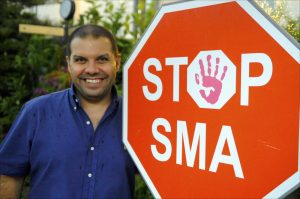Portuguese SMA Expert Urges Early Ventilation, Avoidance of Trach Tubes

Miguel Gonçalves, MD, at an SMA meeting in Warsaw. (Photo by Larry Luxner)
Lifesaving therapies like Spinraza (nusinersen) and others still in trials are indeed important breakthroughs for patients with spinal muscular atrophy (SMA), but they’re still no substitute for time-honored medical strategies like early, machine-assisted ventilation that vastly improve quality of life.
So says respiratory physiotherapist Miguel R. Gonçalves, MD, of Portugal’s São João University Hospital, in his presentation, “Quality of Life in SMA.”
“The drug has no impact if the child does not survive — and the child will only survive with good respiratory management,” said Gonçalves, speaking Aug. 24 at the 6th Polish SMA Conference in Warsaw. “If you give a child Spinraza at the age of 10 days, probably he’ll never develop respiratory failure. I saw a kid in Italy with SMA type 1 who was running. He started taking Spinraza at the age of one month because his brother had SMA and he was diagnosed at birth.”
But most infants who have been lucky enough to access the expensive therapy — which carries a U.S. retail price of $750,000 for the first year and $375,000 every year after that — don’t begin taking it until their second birthday, on average.
More than 400 people attended the event at which Gonçalves spoke. Hosted by Polish nonprofit Fundacja SMA, it was sponsored by Apco, Bjeska, Invicta and other European healthcare firms.
Interested in SMA research? Check out our forums and join the conversation!
Gonçalves, who has lectured in 35 countries, said even patients totally dependent on machines to breathe and cough can enjoy a high quality of life — regardless of what some doctors may think.
“There’s a big difference in the concept of quality of life of children with SMA among health professionals and caregivers. They don’t have experience with SMA,” he said. “Many people think SMA is like a terminal disease, and that when an SMA patient goes to the emergency room or is very sick with criteria to be admitted into the intensive care unit, they should not resuscitate. Yet I’ve never had one mother or father — or a patient with SMA — tell me they want to die.”
Mask improves quality of life
The Portuguese neuromuscular clinic that is part of a pulmonology department where Gonçalves works treats more than 300 patients with neuromuscular diseases; perhaps 20 percent of them have SMA.
“Our patients have good quality of life because we keep their lungs healthy and well-ventilated, and we avoid tracheostomy (trach) tubes, because when it is done in SMA type 1, it’s impossible to reverse,” warned Gonçalves, who graduated from New Jersey Medical School — now part of Rutgers University — and who for the last 15 years has worked closely with John Bach, MD, a prominent American neuromuscular expert.
“Without proper ventilation, many of these patients might be OK for the first two, maybe three years. Then they get pneumonia and go into intensive care, where doctors try to wean them off the ventilator and extubate these patients with spontaneous breathing, and they can’t do it,” said Gonçalves. “They tell the parents to let nature take its course, and that if they want the child to live, it’ll only be with a trach tube. They’ll never gain the ability to speak and will be dependent on the ventilator 24 hours a day.”
Yet “sleeping with a mask does not decrease quality of life,” he said. “On the contrary, SMA patients who are ventilated during the night with efficient noninvasive ventilatory support sleep better, have better appetites and avoid hospitalization. The sooner we start noninvasive ventilation, the better.”
Gonçalves recalled that when he began his career as a respiratory physiotherapist 18 years ago, there were only two types of masks on the market; now patients can choose from more than 50 models.
“During the years on noninvasive ventilatory support, it is important to rotate interfaces to avoid ulcers and damage on the bridge of the nose,” he said. “Children like changing them a lot, and every year the industry puts a new and more fun interface on the market.”
As they get older, Gonçalves puts his patients on mouthpiece ventilation for intermittent daytime ventilatory support or “a sip of fresh air” to help them get through the day, especially if their voice is too low, or their cough is too weak.
“These kids have no movement at all, yet they have an excellent quality of life. They are very intelligent, they have academic degrees, they discuss politics and they can be socially very active,” he said. “The ventilator is never a problem. They also go to baseball and soccer matches and to the zoo. One of my patients with mouthpiece ventilation even went to a plane cockpit to see how a plane is piloted.”
Good ventilation starts at home
During his talk, Gonçalves showed a photo of Dream Music Directory (DMD), a Japanese rock group whose lead singer is confined to a wheelchair. All are ventilator-dependent and all have Duchenne muscular dystrophy — a disease whose abbreviation also is DMD; band members all synchronize between music and breathing.
“Before Spinraza came on the market, there was no motivation for doctors and therapists to keep these people alive,” he said. “Now you have a big industry and everyone wants to get involved. I embrace this investment, and probably thanks to Spinraza, people will start doing what we have been doing for 20 years with no Spinraza. We never believed a cure was necessary to keep these patients alive.”
While extolling the benefits of early ventilation, Gonçalves also stressed how important it is to learn the risks of doing it at home.
“Caregivers must be experts in ambulation, air stacking and helping patients to breathe and cough,” he said. “There are many factors influencing the complexity of setting up home ventilation, so we need to train the team in what patients need. In fact, patients with SMA should themselves be trained to be self-directed in their care, so they can potentially train their own caregivers and fire them when they are not competent. There are also examples of patients who even marry their caregivers.”
With patients living into their 40s these days, Gonçalves said caregivers are themselves becoming too old and sick to offer the constant assistance people with SMA require.
“I now have parents with Alzheimer’s, Parkinson’s and cancer. One mother has been taking care of her child for 60 years. She’s now 90 and still caring for her son,” he said, urging governments around the world to prepare for the reality that SMA patients soon will outlive their parents.
“It’s always been widely accepted that they’d die before their parents. That’s not true anymore,” said Gonçalves, “Countries must prepare to care for these patients as they get older.”










